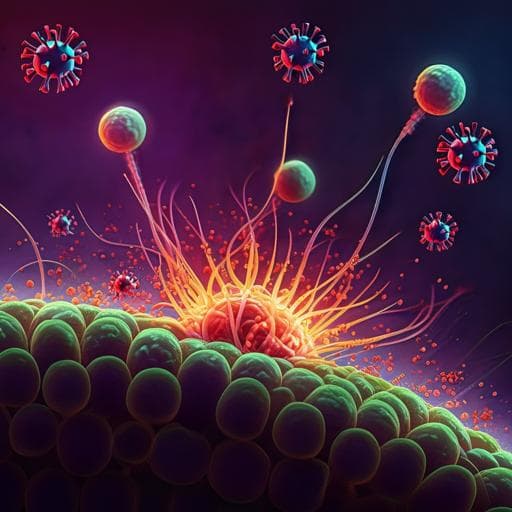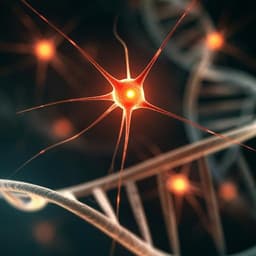
Biology
Viral proteins resolve the virus-vector conundrum during hemipteran-mediated transmission by subverting salicylic acid signaling pathway
J. Zhang, Y. Liu, et al.
This research conducted by Jing-Ru Zhang, Yi-Ming Liu, Di Li, Yi-Jie Wu, Shi-Xing Zhao, Xiao-Wei Wang, Shu-Sheng Liu, Linda L. Walling, and Li-Long Pan uncovers how begomoviruses and their betasatellites evade plant defenses activated by hemipteran insects. Discover how the βC1 protein plays a crucial role in suppressing salicylic acid signaling, a groundbreaking strategy shared among aphid-borne viruses.
~3 min • Beginner • English
Introduction
Plant viruses pose substantial threats to crop production and most depend on hemipteran vectors (whiteflies, aphids, leafhoppers) for inter-plant transmission. Vector feeding delivers virus to new hosts and simultaneously triggers host defenses, notably hormone-mediated immunity. While jasmonate (JA) signaling typically responds to chewing herbivores, hemipteran infestation is associated with accumulation of salicylic acid (SA) and induction of SA-regulated defense genes. SA signaling is also a core component of antiviral immunity in plants, creating a potential conflict for vector-borne viruses whose transmission inherently provokes SA defenses. Viral proteins are known to manipulate host processes, including hormone signaling, to suppress immunity. For begomoviruses associated with betasatellites, the betasatellite-encoded βC1 suppresses JA biosynthesis/signaling to enhance vector performance. However, how vector-mediated SA signaling affects virus infection, and whether vector-borne viruses evolved strategies to counter SA defenses elicited by their vectors, has remained unclear. Here the authors investigate whether whitefly-induced SA impacts begomovirus infection and how co-infecting betasatellites and other vector-borne viruses subvert SA signaling to promote infection and transmission.
Literature Review
Prior studies establish: (1) Hemipteran feeding commonly induces SA accumulation and SA-responsive gene expression in plants, while chewing herbivores activate JA signaling. (2) SA signaling mediates antiviral defenses across diverse plant-virus systems; exogenous SA or SA pathway components can limit viral replication. (3) Viral proteins target plant hormone pathways; for begomovirus-betasatellite complexes, βC1 suppresses JA signaling and aids vector performance. (4) Several RNA virus effectors (e.g., CMV 2b, TuMV HC-Pro) have been reported to interfere with SA-mediated defenses. Despite this, direct mechanisms by which vector-borne viruses overcome vector-induced SA defenses during transmission have been poorly characterized. This study situates itself at the intersection of vector-induced SA immunity and virus-encoded suppression mechanisms, focusing on the HSP90–NPR3 node in SA signaling.
Methodology
- Plant and insect systems: Tobacco (Nicotiana tabacum cv. NC89), tomato (Solanum lycopersicum cv. Moneymaker), and N. benthamiana were grown under controlled conditions. Bemisia tabaci whiteflies were reared on cotton and used to infest plants (100–200 adults per plant for 48 h) in cages; non-infested plants served as controls.
- Viruses and constructs: Begomoviruses tobacco curly shoot virus (TbCSV) and tomato leaf curl New Delhi virus (ToLCNV) and their betasatellites (TbCSB, ToLCNB) were agro-infiltrated into hosts, either alone or in combination. A mutant TbCSB (mtTbCSB) unable to express βC1 was used to test βC1 function. Transgenic N. benthamiana lines constitutively expressing βC1 proteins (from TbCSB or ToLCNB), CMV 2b, or TuMV HC-Pro were generated and validated by RT-PCR and phenotype.
- SA/JA quantification and treatments: SA, SAG, JA, and JA-Ile levels were quantified by LC-MS/MS. Plants were foliar-sprayed with SA (typically 0.5–10 mM; 0.2% ethanol as control) once daily for up to three days. GDA (inhibitor; dissolved in DMSO) was used in some assays to probe HSP90 involvement.
- Virus accumulation and gene expression: Virus levels were quantified by qPCR, normalizing to plant actin. Expression of SA marker genes PR1a and PR2 was assessed by qPCR in various genotypes and treatments.
- Protein interaction assays: GST pull-downs with E. coli-expressed GST–βC1 were incubated with N. benthamiana extracts; interacting proteins were identified by mass spectrometry, revealing NbHSP90s. Interactions were validated by bimolecular fluorescence complementation (BiFC), yeast two-hybrid (Y2H), and co-immunoprecipitation (co-IP) between βC1 (and CMV 2b, TuMV HC-Pro) and NbHSP90 isoforms.
- Protein degradation assays: Semi-in vivo and in vitro degradation assays examined SA-induced turnover of NbNPR3-Flag in the presence or absence of βC1, HSP90 inhibitors (e.g., MG132 for proteasome, GDA), or co-expressed NbHSP90s. Cycloheximide (CHX) and ATP were included to assess degradation kinetics. Effects of viral proteins on SA-induced NbNPR3 degradation were quantified by western blotting.
- Gene function analyses: Virus-induced gene silencing (VIGS) targeted NbHSP90 isoforms and NbNPR3 to test requirements for βC1-mediated suppression of SA signaling. NahG transgenic plants degrading SA were used to confirm SA dependence of whitefly-induced resistance.
- Statistics: Data presented as mean ± SEM. Two-sided t-tests or one-way ANOVA with LSD were used; significance at P < 0.05. Experiments were replicated at least once with similar results.
Key Findings
- Whitefly infestation (48 h) significantly increased SA (and SAG) levels in tobacco and N. benthamiana; JA and JA-Ile were largely unchanged in N. benthamiana.
- Whitefly-induced SA accumulation enhanced antiviral resistance against begomovirus TbCSV, reducing virus accumulation and symptom severity; this effect was absent when TbCSV was co-inoculated with its betasatellite TbCSB.
- Exogenous SA sprays reduced TbCSV accumulation. In tobacco, 10 mM SA decreased TbCSV to ~20% of control levels; in TbCSV+TbCSB infections, SA still reduced virus but less strongly (to ~26% of control), indicating partial antagonism by the betasatellite.
- In N. benthamiana, whitefly-induced antiviral resistance was abolished in SA-degrading NahG plants, confirming SA dependence; whitefly-induced resistance was observed for TbCSV but not for TbCSV+TbCSB.
- βC1 is necessary for antagonizing SA-regulated resistance: a betasatellite mutant lacking βC1 failed to suppress SA-induced resistance; βC1-overexpressing transgenic plants showed reduced SA-responsive PR1a/PR2 induction and diminished SA-mediated antiviral resistance.
- βC1 did not reduce SA content; instead, it interfered with SA signaling downstream. Both TbCSV and TbCSV+TbCSB activated PR1a/PR2 transcripts, but βC1 dampened SA-dependent responses.
- Mechanism: GST pull-down and MS identified NbHSP90 proteins as βC1 interactors. BiFC, Y2H, and co-IP confirmed βC1 association with multiple NbHSP90 isoforms. NbHSP90s also interact with NbNPR3, a negative regulator of SA signaling; βC1 does not directly bind NbNPR3.
- SA induces proteasome-dependent degradation of NbNPR3; βC1 blocks SA-induced NbNPR3 turnover in an NbHSP90-dependent manner. MG132 prevented degradation; HSP90 perturbation altered the effect, indicating the HSP90–NPR3 axis is required.
- VIGS showed that both NbHSP90s and NbNPR3 are required for βC1-mediated suppression of SA signaling: silencing these genes altered PR1a/PR2 responses and virus accumulation under SA treatment.
- Conservation across viruses: Aphid-borne virus effectors CMV 2b and TuMV HC-Pro interacted with NbHSP90s, reduced SA-induced PR1a/PR2 expression in transgenic plants, and impeded SA-induced NbNPR3 degradation, indicating convergent targeting of the HSP90–NPR3 node by diverse vector-borne viruses.
Discussion
The study addresses how vector-borne plant viruses overcome the SA-mediated antiviral defenses that are inherently triggered by hemipteran feeding during transmission. The data demonstrate that whitefly-induced SA signaling restricts begomovirus infection; however, the associated betasatellite-encoded βC1 counteracts this defense. βC1 acts not by lowering SA levels but by suppressing SA signaling through stabilization of the negative regulator NbNPR3. βC1 engages NbHSP90s, which serve as chaperones for NbNPR3, thereby blocking the SA-induced, proteasome-dependent turnover of NbNPR3. Stabilized NbNPR3 sustains repression of SA-responsive genes (PR1/PR2), weakening antiviral immunity and facilitating virus replication and persistence. This HSP90–NPR3-centered mechanism appears to be a point of convergence exploited by unrelated vector-borne viruses (begomoviruses with betasatellites, CMV, TuMV), underscoring its evolutionary importance in the vector–virus–plant triad. These insights reveal how viruses reconcile the paradox of requiring vectors that simultaneously activate antiviral defenses: by deploying effectors that subvert the induced SA pathway at a key regulatory hub.
Conclusion
This work uncovers a conserved strategy by which vector-borne plant viruses subvert host SA signaling triggered by hemipteran infestation. Betasatellite βC1 proteins, and effectors from aphid-borne viruses (CMV 2b, TuMV HC-Pro), bind plant HSP90s to prevent SA-induced degradation of the SA pathway repressor NPR3, thereby suppressing PR gene induction and antiviral resistance. The findings reconcile the virus–vector conundrum and highlight the HSP90–NPR3 complex as a critical node in antiviral immunity that is targeted by diverse viruses. Future research should: (1) define the precise HSP90 domains and co-chaperone requirements manipulated by βC1 and other viral proteins; (2) map NPR3 modification sites and ubiquitination machinery involved in SA-induced turnover; (3) extend analyses to additional hemipteran vectors and virus families; and (4) explore breeding or biotechnological strategies to disrupt viral engagement of HSP90–NPR3 to enhance crop resistance.
Limitations
- Many experiments were performed in N. benthamiana, which may not fully generalize to all crop species.
- Overexpression in transgenic lines and agro-infiltration may not perfectly recapitulate native protein levels or infection dynamics.
- Exogenous SA concentrations (up to 10 mM) and repeated sprays may differ from endogenous induction during vector feeding.
- The exact molecular details of how βC1 modulates HSP90 function and how this prevents NPR3 turnover remain unresolved.
- Only a subset of HSP90 isoforms and viral proteins were tested; broader surveys could reveal additional interactions or exceptions.
Related Publications
Explore these studies to deepen your understanding of the subject.







